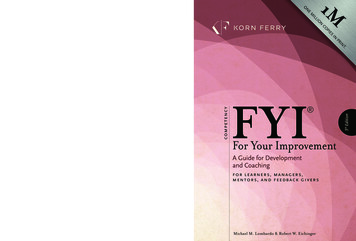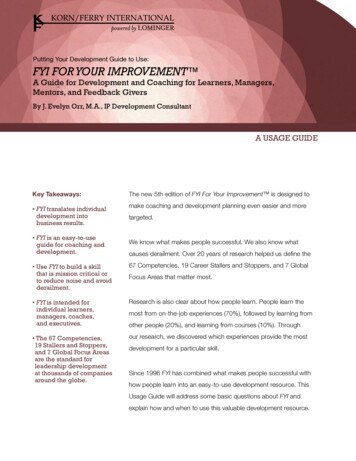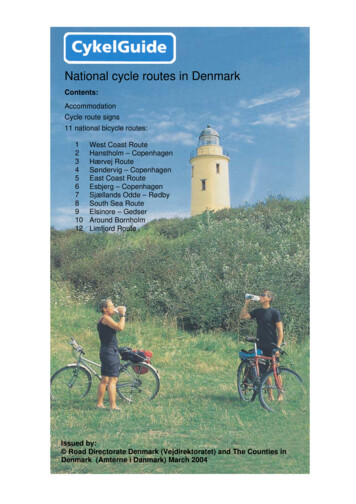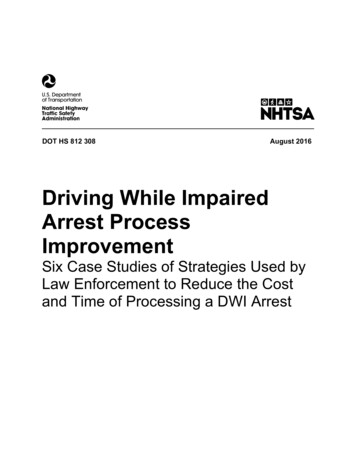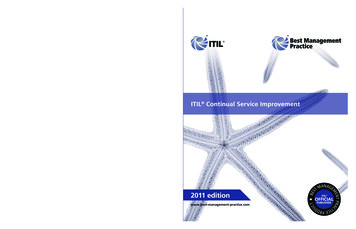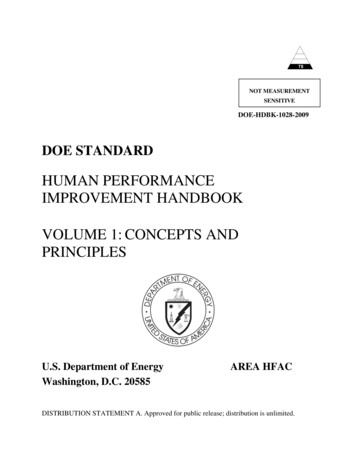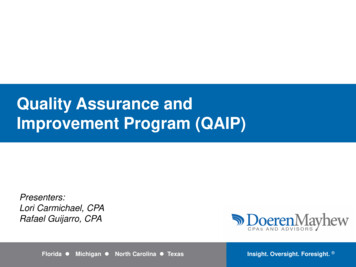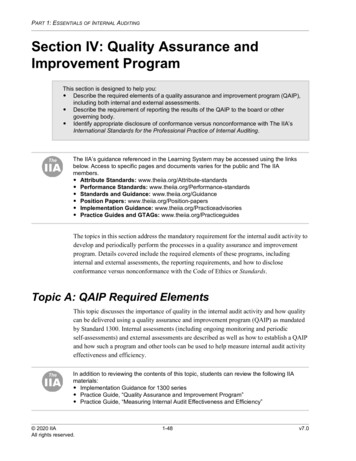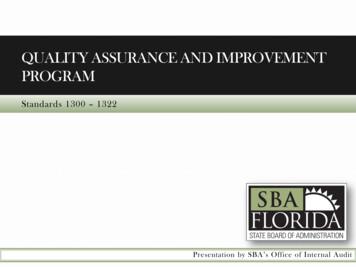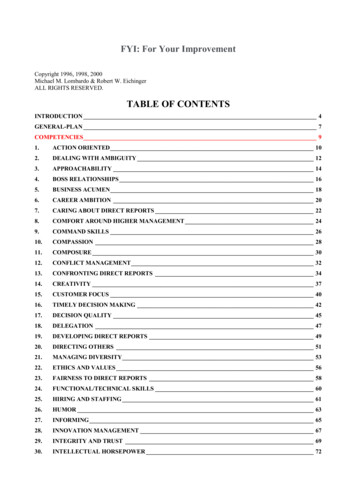
Transcription
FYI: For Your ImprovementCopyright 1996, 1998, 2000Michael M. Lombardo & Robert W. EichingerALL RIGHTS RESERVED.TABLE OF CONTENTSINTRODUCTION 4GENERAL-PLAN 7COMPETENCIES 91.ACTION ORIENTED 102.DEALING WITH AMBIGUITY 123.APPROACHABILITY 144.BOSS RELATIONSHIPS 165.BUSINESS ACUMEN 186.CAREER AMBITION 207.CARING ABOUT DIRECT REPORTS 228.COMFORT AROUND HIGHER MANAGEMENT 249.COMMAND SKILLS 2610.COMPASSION 2811.COMPOSURE 3012.CONFLICT MANAGEMENT 3213.CONFRONTING DIRECT REPORTS 3414.CREATIVITY 3715.CUSTOMER FOCUS 4016.TIMELY DECISION MAKING 4217.DECISION QUALITY 4518.DELEGATION 4719.DEVELOPING DIRECT REPORTS 4920.DIRECTING OTHERS 5121.MANAGING DIVERSITY 5322.ETHICS AND VALUES 5623.FAIRNESS TO DIRECT REPORTS 5824.FUNCTIONAL/TECHNICAL SKILLS 6025.HIRING AND STAFFING 6126.HUMOR 6327.INFORMING 6528.INNOVATION MANAGEMENT 6729.INTEGRITY AND TRUST 6930.INTELLECTUAL HORSEPOWER 72
31.INTERPERSONAL SAVVY 7332.LEARNING ON THE FLY 7633.LISTENING 7834.MANAGERIAL COURAGE 8035.MANAGING AND MEASURING WORK 8236.MOTIVATING OTHERS 8337.NEGOTIATING 8538.ORGANIZATIONAL AGILITY 8839.ORGANIZING 8940.DEALING WITH PARADOX 9041.PATIENCE 9342.PEER RELATIONSHIPS 9543.PERSEVERANCE 9744.PERSONAL DISCLOSURE 9945.PERSONAL LEARNING 10146.PERSPECTIVE 10347.PLANNING 10548.POLITICAL SAVVY 10749.PRESENTATION SKILLS 10950.PRIORITY SETTING 11251.PROBLEM SOLVING 11352.PROCESS MANAGEMENT 11653.DRIVE FOR RESULTS 11854.SELF DEVELOPMENT 12055.SELF KNOWLEDGE 12256.SIZING UP PEOPLE 12457.STANDING ALONE 12658.STRATEGIC AGILITY 12859.MANAGING THROUGH SYSTEMS 13160.BUILDING EFFECTIVE TEAMS 13361.TECHNICAL LEARNING 13562.TIME MANAGEMENT 13663.TQM/RE-ENGINEERING 13864.UNDERSTANDING OTHERS 14065.MANAGING VISION AND PURPOSE 14366.WORK/LIFE BALANCE 14567.WRITTEN COMMUNICATIONS 147PERFORMANCE DIMENSIONS 15081.QUANTITY OF OUTPUT OF WORK 15082.TIMELINESS OF DELIVERY OF OUTPUT 152
83.QUALITY OF WORK OUTPUT 15484.USE OF RESOURCES 15685.CUSTOMER IMPACT / VALUE ADDED 15886.FREEDOM FROM UNPLANNED SUPPORT 16087.TEAM/UNIT CONTRIBUTION 16288.PRODUCTIVE WORK HABITS 16489.ADDING SKILLS AND CAPABILITIES 166CAREER STALLERS AND STOPPERS 169101.UNABLE TO ADAPT TO DIFFERENCES 169102.POOR ADMINISTRATOR 171103.OVERLY AMBITIOUS 172104.ARROGANT 174105.BETRAYAL OF TRUST 176106.BLOCKED PERSONAL LEARNER 178107.LACK OF COMPOSURE 180108.DEFENSIVENESS 182109.LACK OF ETHICS AND VALUES 184110.FAILURE TO BUILD A TEAM 186111.FAILURE TO STAFF EFFECTIVELY 188112.INSENSITIVE TO OTHERS 190113.KEY SKILL DEFICIENCIES 192114.NON-STRATEGIC 193115.OVERDEPENDENCE ON AN ADVOCATE 195116.OVERDEPENDENCE ON A SINGLE SKILL 197117.OVERMANAGING 199118.PERFORMANCE PROBLEMS 200119.POLITICAL MISSTEPS 202
INTRODUCTIONWHO IS THIS BOOK FOR?This book of development tips was designed for any motivated person with a need – at any level (manager, executive,individual contributor or citizen), for problems at work or in one’s personal life.We know that anyone who has not yet accepted a need or limitation or weakness or developmental opportunity will notbe helped by what’s in this book. If you are still in denial, rationalizing, confused or being defensive about having anyneeds, seek additional feedback and counsel before using this book.We also find people who do take personal responsibility for a need but do not have the motivation or drive or urgencyor energy to do anything about it. Similarly, they won’t be helped by what’s in this book. If you don’t think your needmatters, talk to your mentor or someone higher up in the organization and ask him/her why this need may get in yourway. Be able to see how the need plays out for you and what consequences it has that are unacceptable for you.The 5,000 plus tips in this book will help anyone who recognizes specific needs and is motivated to do something aboutthem. If that’s you, read on.WHERE DID THESE 67 COMPETENCIES, 9 PERFORMANCE DIMENSIONS AND 19 CAREERSTALLERS AND STOPPERS COME FROM?The LEADERSHIP ARCHITECT Competencies come from a content analysis of many sources: the major andcontinuing studies at the Center for Creative Leadership, long-term studies at AT&T and Sears, studies by Harry andDaniel Levinson, Kotter, Gabarro, Jaques, Kouzes and Posner, Bennis, Tichy and Bass’s The Handbook of Leadership– a compendium of empirical studies.The nine PERFORMANCE MANAGEMENT ARCHITECT dimensions come from a review of commonperformance evaluation measures. They apply in most, if not all jobs, from entry to the boardroom. We have numberedthem from 81-89, fitting them in-between the 1-67 Core Competencies (with space for more at some future time), andthe 101-119 Career Stallers and Stoppers.The Career Stallers and Stoppers come primarily from three sources: the continuing work of the Center for CreativeLeadership, the work of Jon Bentz while he was at Sears and from the executive development work and experiences ofthe authors.Research with Lominger’s VOICES , a 360º feedback instrument using these Competencies and Stallers and Stoppers,indicates they can be measured reliably and are significantly related to current job performance. Some are also relatedto potential for promotion as well.WHERE DID THE REMEDIES IN FOR YOUR IMPROVEMENT COME FROM?FYI consists of 950 topics (10 for each of 67 Competencies, 9 Performance Dimensions and 19 Stallers and Stoppers)and thousands of individual tips for your development.Where they existed, we used research findings – on creativity or composure, for example. There is a fairly rich array ofresearch on competencies – what experiences teach them, what they look like, what their elements are. You’ll seereferences to the best books that we’ve seen on the various topics in the pages that follow.Additionally, the authors have been in the development business for a combined 50 years, on both the research end andthe practical end. We’ve heard thousands of executives and managers describe their difficulties during feedbacksessions, figured out with them what’s getting in their way, and have tested our ideas for fixing things with them. Weknow from experience and research what tips are most likely to work.GUIDING PRINCIPLES BEHIND THE REMEDIES1. Brief. Most of the readers, being motivated people with needs, want to get started right away. They want the lowhanging fruit. They want quick help. The tips were designed to help people get started quickly and see results assoon as they begin executing the tips.2. Things everyone could and would do. There are many more complex and involved problem solving methods, forexample, that are not included here. In FYI, we assume that you’re not very good at whatever you’re readingabout, and would appreciate tips that don’t assume you are practiced or proficient. You just want to get started anddo something.
3.4.Just the 10 key topics. Hard as it was to hold ourselves to 10 topics per Competency, Dimension, or Staller andStopper, we believe the 10 most likely or 10 most common topics to deal with will do you the most good. Wherethe topic is quite complex, we generally recommended a book as well.Quick results. While some of our topics involve longer term effort, most are things you can do tomorrow andhopefully see some quick improvement.BOOK RECOMMENDATIONSIn previous editions, we included some book references and were told by users that they would like references for eachCompetency, Performance Dimension or Staller. Accordingly, we have added hundreds of books and audiotapes tohelp you go beyond the tips we present in these pages. Each of the 95 chapters in FYI has 4 to 15 sources for furtherreading or listening.We used these selection criteria:1. ROI – Is there a significant and immediate payoff for reading this book? Are there sugg
BOOK RECOMMENDATIONS In previous editions, we included some book references and were told by users that they would like references for each Competency, Performance Dimension or Staller. Accordingly, we have added hundreds of books and audiotapes to help you go beyond the tips we present in these pages. Each of the 95 chapters in FYI has 4 to 15 .
